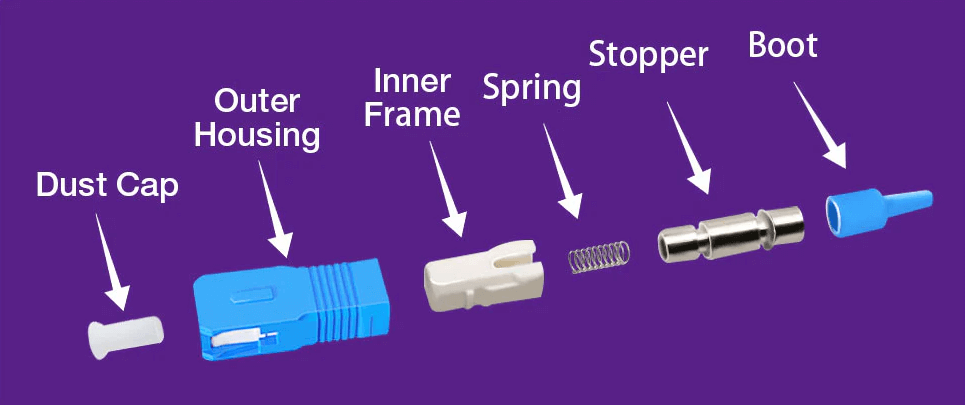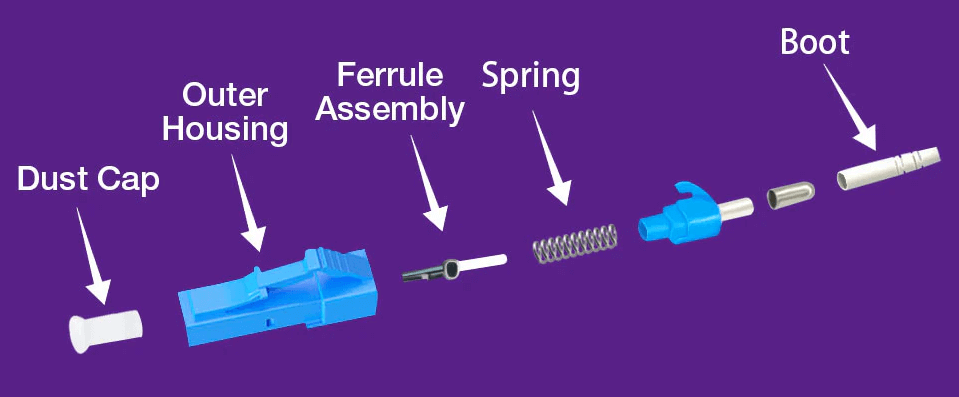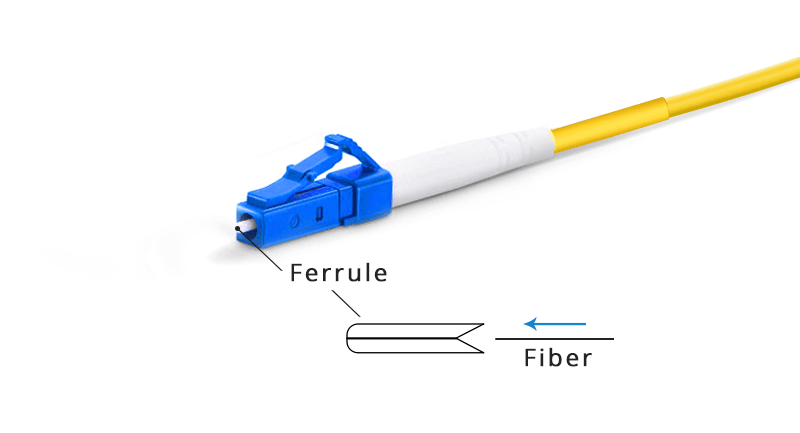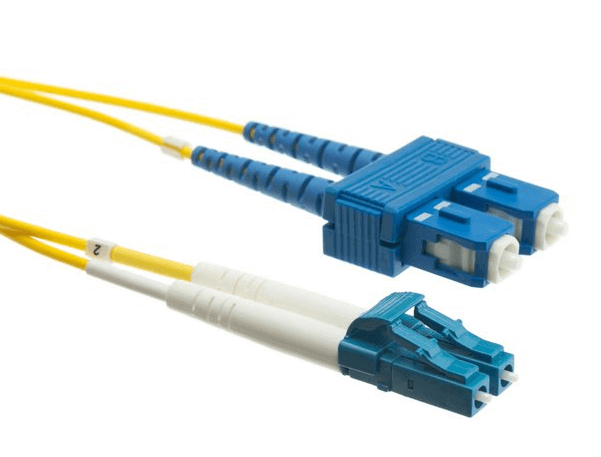Fiber-Optic Connectors: SC vs. LC
To achieve optimal performance from fiber optic technologies in data management and telecommunications, one must decide between SC and LC connectors. This article explores the performance, design, and practical uses of SC and LC connectors. It compares their insertion loss, return loss, physical size, cable compatibility, and design innovations to show how each meets different needs. It also looks at the pros and cons of each connector type, offering insights into their use in different industries, especially in high-demand areas like telecom and data centers. Matching the right connector with the right application can boost efficiency, reduce problems, and make the most of fiber optic advances for better network performance.Catalog

Figure 1: LC and SC Fiber Optic Connectors
Performance Comparison
Insertion Loss
Insertion loss measures the signal power loss when a connector is added to a transmission line. It is measured in decibels (dB), with lower values indicating better performance and minimal signal degradation. LC connectors are ideal for data centers where space is limited. They usually have an insertion loss between 0.2 and 0.5 dB, showing their ability to maintain signal integrity, for long-distance telecommunications and high-capacity networks. SC connectors, known for their durability and ease of use due to their push-pull mechanism, have an insertion loss of 0.25 to 0.5 dB. Although slightly higher than LC connectors, SC connectors still provide low insertion loss levels, making them suitable for digital and analog transmissions and CATV networks.
Return Loss
Return loss measures the amount of light reflected back to the source when it hits a connector. Higher return loss is better as it means less signal reflection, which can interfere with transmission quality. LC connectors often achieve return loss values over 55 dB due to their secure physical contact and finely polished tips. This makes them perfect for high-speed data transmissions and high-resolution video networking, where back reflections are a concern. SC connectors also have good return loss performance, usually around 50 dB. This level of performance is right for maintaining signal integrity in various optical networks, thanks to the connector’s design that ensures good physical contact and reduces signal reflection.
Performance in Corporate Sectors
The corporate world demands fast, efficient, and stable performance when it comes to data communication. Both LC and SC fiber connectors are designed for strong, interference-free data transmission.
Features and Design Comparison

Figure 2: Basic of SC Connector

Figure 3: Basic of LC Connector
Physical Size
The SC connector has a 2.5mm ferrule, making it a standard choice for fiber optic networks. It's known for being durable and reliable, and it's great for situations where strength and easy handling are important. On the other hand, the LC connector, with its smaller 1.25mm ferrule, is perfect for modern networks that need more compact and efficient options.
The LC connector's smaller size is useful in places with limited space, like data centers and telecom facilities. It allows for twice as many connections per rack unit compared to SC connectors, boosting the capacity of fiber optic panels and equipment without taking up more physical space. This meets the International Electrotechnical Commission (IEC 61754-20) standards, ensuring that LC connectors are consistent and compatible with different networking devices. This standardization need for the wide use of LC connectors in high-density applications, supporting areas like cloud computing and data management where more connections are require without extra space or cost.

Figure 4: Ferrule
Cable Diameter and Compatibility
Choosing between SC and LC connectors depends on the cable size and the environment where they will be used. SC connectors work well with thicker cables, about 2.5mm or 3.0mm, making them durable and able to handle physical stress. This makes them great for industrial areas or places where cables might get damaged. Their strong build ensures the network stays connected even in tough conditions.
LC connectors, on the other hand, are made for thinner cables, around 0.9mm or 1.6mm. They are ideal for places where saving space and flexible cables are right. These connectors are useful in small network areas and data centers where efficient cable management is required. Deciding between SC and LC connectors is right not just for physical reasons but also because it affects network design, performance, and ensuring the network works well and can grow.

Figure 5: SC and LC Fiber Cable
Design Innovations and Usability
Design innovations improve the usability of fiber optic connectors to meet specific needs. The SC connector's traditional push-pull mechanism, while secure, can be cumbersome in high-density applications due to the required space.
The LC connector, with its clip-locking mechanism, ensures secure connections and facilitates easy engagement and disengagement in tight spaces, which is invaluable for environments needing quick, efficient, and frequent network access.
LC connectors are available in both simplex and duplex configurations, offering flexibility for various networking scenarios. Simplex connectors handle single data transmission paths, while duplex connectors support bidirectional communication, for high-speed data systems. This versatility makes LC connectors suitable for a broad range of applications and simplifies network design.
The distinct latching mechanisms of SC and LC connectors highlight their respective usability and security advantages. The SC connector's strong push-pull design provides a secure connection but may not be ideal in spaces where conservation and operational speed are valuable. The LC connector's clip-locking mechanism offers advantages in speed and ease of use, allowing quicker and more secure connections without requiring extra space or force, especially beneficial in high-vibration environments.

Figure 6: Push-Pull Locking Connectors
Advantages and Disadvantages of SC and LC Fiber Connectors

Figure 7: SC Fiber Connectors

Figure 8: LC Fiber Connectors
Advantages of SC Connectors
SC connectors, recognized by their square-shaped ferrule, excel at optimizing space in tight areas, surpassing the cylindrical ST connectors. The square design helps organize many connectors neatly in dense settings, ensuring stable and secure connections. One notable feature of SC connectors is their strong locking mechanism. This design keeps the connector firmly in place even when the cable is pulled, preventing accidental disconnections—a common issue with ST connectors where cable tension can disrupt the signal.
SC connectors are versatile. They can integrate with other fiber optic connectors like FC and ST using a hybrid adapter. This compatibility supports seamless integration in various network setups, making them valuable for telecommunications and data center applications. SC connectors are known for their easy, plug-and-play installation. This simplicity speeds up setup times and is particularly useful in environments requiring frequent fiber optic connections and disconnections, minimizing downtime and technical issues. Moreover, SC connectors are cost-effective, making them a popular choice for establishing new networks and upgrading existing ones.
Advantages of LC Connectors
Because of its small size, LC connectors are highly valued in environments with limited space, such as packed data centers and telecom racks. The small size, also known as the Lucent Connector, allows for higher connection density and maximizing space efficiency. The LC connector has a snap coupling latch mechanism that simplifies connecting and disconnecting, improving operational efficiency in environments with frequent network changes.
LC connectors are designed for high signal integrity, exhibiting low insertion loss and minimal back reflection for clear signals in high-speed data transmission. These performance traits make LC connectors ideal for demanding telecommunications and high-frequency data transfer. The secure latch ensures reliable data flow, reducing the risk of signal interruptions or data loss for consistent performance. The combination of compactness, increased connection density, and superior technical performance drives the growing preference for LC connectors in advanced fiber optic networks.
Disadvantages of Both Connectors
SC and LC connectors have drawbacks affecting their use in certain scenarios. The smaller size of LC connectors, while space-saving, makes manual handling challenging and increases the risk of damage if not managed carefully. This can be a hindrance in environments requiring quick and repeated handling of connections. SC connectors, with their larger ferrules, require more physical space than the streamlined LC designs, making them less ideal for extremely confined or densely populated areas.
Both connectors also present challenges in installation. Though designed for straightforward handling, the precision to align and secure fiber optic cables can be daunting for less experienced technicians. An increase in signal loss during installation might be caused by improper handling, which will seriously hinder network performance. While SC connectors are generally more affordable, the higher initial costs of LC connectors, due to their advanced design, may deter some organizations from choosing them for large-scale deployments or upgrades, despite their technical benefits.
SC vs LC Applications
In telecommunications, SC connectors are valued for their durability and user-friendly design. These connectors are built to withstand frequent use and environmental challenges typical in telecom environments. The 'stick-and-click' mechanism simplifies connections, reducing the risk of errors and ensuring uninterrupted operation of communication networks. The strong design of SC connectors minimizes the chance of disconnections or damage, enhancing the stability and reliability of network connections in various telecommunications settings.
In data centers, LC connectors are required to achieve high bandwidth requirements in a compact frame. Due to their architecture, modern organizations may handle their expanding data needs with a large increase in the number of fiber connections per rack unit. As data centers expand, the adaptability and capacity of LC connectors to accommodate new technologies and higher data volumes are required. This ensures scalable data transmission and infrastructural flexibility, maintaining the operational agility required by data-driven enterprises.
Conclusion
The analysis shows that choosing between SC and LC connectors greatly affects network efficiency, space use, and overall performance in telecom and data centers. SC connectors are easy to use, making them good for settings needing durability and frequent handling. LC connectors excel in high-density areas where saving space and minimizing signal interference are important. LC connectors offer higher connection density and lower insertion and return losses, making them ideal for modern, high-speed data and scalable networks. However, their small size and installation precision pose challenges. SC connectors are simpler and more cost-effective for many traditional setups, despite being larger. The choice between SC and LC should consider specific network needs, environment constraints, and future scalability to ensure the solution aligns with business goals and supports a strong and efficient communication infrastructure.
Frequently Asked Questions [FAQ]
1. Which is better, SC or LC connector?
The SC connector is favored for its durability and simple push-pull engagement mechanism, which makes it suitable for telecommunication networks and CATV networks. It is durable, cost-effective, and well-suited for high-density connections. The LC connector, on the other hand, is more compact and uses a secure latch mechanism. It is preferred for data communication environments like data centers due to its smaller size, which allows for higher port density on equipment like patch panels and switches. The LC connector is also compatible with a wider range of modern transceiver modules, including SFP (Small Form-factor Pluggable) modules.
2. Can an LC connector connect to an SC connector?
Directly connecting an LC connector to an SC connector is not feasible because each has a different size and latch mechanism. To bridge devices with these two different connectors, one would use a hybrid adapter or a patch cable that has an LC connector on one end and an SC connector on the other. This setup ensures compatibility and a secure connection between equipment with different interface types.
3. Can LC connectors be used on single mode fiber?
Yes, LC connectors can be used on single mode fibers. They are designed to support both single mode and multimode fiber types. The precision and compact design of LC connectors make them effective for single mode applications, which require precise alignment to minimize signal loss and reflections.
4. What is the typical loss of LC connectors?
The typical insertion loss for LC connectors ranges from 0.1 to 0.5 decibels per connection. This performance metric is good in maintaining the efficiency of the fiber optic network, ensuring minimal signal attenuation at connection points. The actual loss depends on the quality of the fiber, the connector itself, and the precision with which it has been terminated and polished.
5. How do you separate LC connectors?
Separating LC connectors involves disengaging the latch that secures the connector into its adapter. First, locate the small latch on the top of the LC connector. Gently depress this latch downwards and firmly pull the connector straight out from the adapter or port. In order to shield the internal fiber from harm, the connector must not be bent or twisted.
6. What color are LC and SC connectors?
The color coding of LC and SC connectors indicates the type of fiber optic cable used. For single mode fibers, both LC and SC connectors are blue. For multimode fibers, they can be beige or aqua, depending on the optical mode and performance specifications (OM1, OM2, OM3, OM4). This color coding helps in quickly identifying the type of fiber during installation and maintenance, thus preventing misconnections.